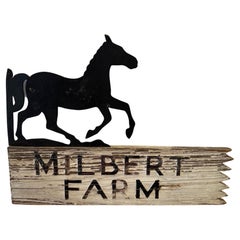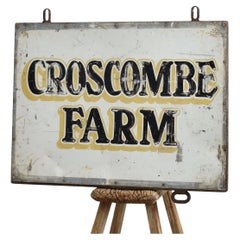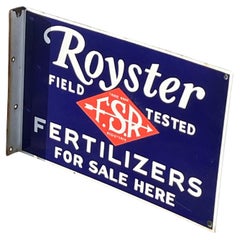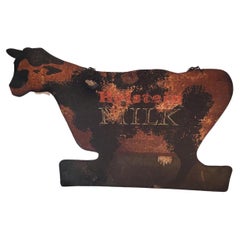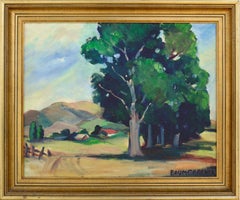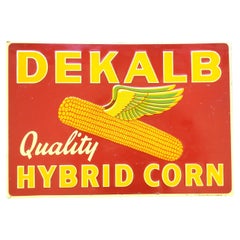Farm Sign
to
56
230
90
240
80
73
52
45
30
26
22
17
14
13
12
10
10
9
9
8
7
4
4
4
3
2
2
2
2
1
1
24
7
7
5
4
Sort By
Authentic Antique Folk Art Equestrian Horse Farm Sign
Located in Hopewell, NJ
Charming hand made vintage horse farm sign that is finished front and back. The horse and letters
Category
Vintage 1930s American Folk Art Signs
Materials
Iron
Antique Vintage Rustic Folk Art Metal Farm Sign
Located in Stockbridge, GB
Antique Metal Farm Sign
An original metal hanging sign which would have hung at the entrance to
Category
Mid-20th Century English Rustic Signs
Materials
Cut Steel
Royster Fertilizer Porcelain Two Sided Farm and Agricultural Farm Sign w/Flange
Located in New York, NY
Vintage Roysrer farm and agricultural porcelain advertising sign . Exact image on both sides with
Category
Mid-20th Century American Country Wall-mounted Sculptures
Materials
Enamel
$760 Sale Price
20% Off
H 12 in W 18.5 in D 1.5 in
Antique Dutch Enameled Metal Farm Animal Feed Sign
Located in Rio Vista, CA
Antique Dutch enameled metal farm animal feed sign featuring a bull and a rooster. Metal Folk Art
Category
20th Century Dutch Folk Art Signs
Materials
Metal, Enamel
Holstein Milk Painted Metal Trade Sign
Located in Los Angeles, CA
This folky original painted hand made Holsteins Milk metal farm trade sign has the original chain
Category
20th Century American Folk Art Signs
Materials
Metal
Farm in the Valley - Plein Air California Landscape
Located in Soquel, CA
by more trees. There are rolling golden hills in the distance behind the farm.
Signed "Baumgardner
Category
20th Century American Modern Landscape Paintings
Materials
Canvas, Oil
Fireplace Farm: Springs, East Hampton
By Gerard Giliberti
Located in East Hampton, NY
Fireplace Farm Sign Springs, East Hampton NY, Archival Pigment Print, $550, Ed. 1/5, 2014
Printed
Category
2010s Symbolist Color Photography
Materials
Archival Pigment
Henry Percy - 20th Century Oil, A Prickly Find
Located in Corsham, GB
the farm. Signed by the artist to the lower left. On board.
Category
20th Century Animal Paintings
Materials
Oil
$280 Sale Price
20% Off
H 8.43 in W 10.56 in
Mid-Century Embossed Dekalb Hybrid Corn Advertising Farm or Mercantile Sign
By St. Thomas Metal Signs
Located in Hamilton, Ontario
This vintage sign was made by the St. Thomas Metal Sign Company of St. Thomas Ontario Canada and
Category
Mid-20th Century Canadian Mid-Century Modern Historical Memorabilia
Materials
Metal
$899
H 13.25 in W 19.25 in D 0.25 in
Early 20th Century Signed Etching By Armin Carl Hansen -- Valley Farm
By Armin Hansen
Located in Soquel, CA
Signed 1926 Armin Carl Hansen Etching and Drypoint of Central Coast California Valley Farm
Category
1920s American Impressionist Landscape Prints
Materials
Laid Paper, Etching
$2,380
H 15 in W 20 in D 0.25 in
Marguerite Wildenhain pottery / stoneware vase/ vessel signed . Bauhaus artist
By Pond Farm, Marguerite Wildenhain
Located in Los Angeles, CA
.Signed Pond Farm plus her mark. Including handles measures 8.5 inches. alone diameter 6.7 inches.
Category
Mid-20th Century American Modern Vases
Materials
Pottery
$2,200
H 8.5 in Dm 6.7 in
Signed Andre Vignoles Framed Landscape Farm Painting
By André Vignoles
Located in Locust Valley, NY
This signed André Vignoles framed landscape farm painting, is depicting a vibrant countryside scene
Category
Mid-20th Century Unknown French Provincial Paintings
Materials
Wood, Paper
"Newton’s Farm" Georgina Klitgaard, Modernist Hazy Autumn Landscape Painting
By Georgina Klitgaard
Located in New York, NY
Georgina Klitgaard
Newton’s Farm
Signed lower right
Oil on canvas
24 1/2 x 30 1/2 inches
Georgina
Category
Early 20th Century American Modern Figurative Paintings
Materials
Canvas, Oil
Knox Farm Polo July 21 Yellow/ Navy Sign
Located in Bristol, CT
Sz: 18"H x 23 3/4"W
Double-sided cardboard
East Aurora, NY
Mounted on metal divot
22 1/2" x 10"W
Category
21st Century and Contemporary More Art
Materials
Cardboard
French Post-Impressionist Farm Landscape Signed Oil Painting
By Claude Benard
Located in Cirencester, Gloucestershire
Farm Landscape, Signed Oil Painting
By French artist Claude Benard, (1926 - 2016)
Signed by the
Category
Mid-20th Century Post-Impressionist Landscape Paintings
Materials
Oil
$3,435
H 31.5 in W 41.75 in D 1 in
Vintage English Pub Sign Artwork Duncan Dawson Dairy Farm
Located in Tyler, TX
English Vintage Hanging Pub Sign ~~Duncan Dawson Dairy Farm~~ Dairy Cow
21" tall x 26" wide x .75
Category
Late 20th Century English Sporting Art Decorative Art
Materials
Wood, Paint
Farm
Located in Houston, TX
Beautiful French ink wash painting of farm, circa 1940. Signed lower right.
Original artwork on
Category
1940s Landscape Drawings and Watercolors
Materials
Ink
FARM WOMAN Signed Lithograph, Lowcountry Landscape Gullah Geechee Culture Quilts
By Jonathan Green
Located in Union City, NJ
Geechee farm life.
Print size - 28 x 35 inches, unframed, excellent condition, hand signed in pencil by
Category
Early 2000s Contemporary Portrait Prints
Materials
Lithograph
Architectural Painting #4 Farm House. Signed by Artist Sue Wall
Located in Norton, MA
Photo realist acrylic painting on canvas, architectural scene of Victorian Brick House, signed Sue
Category
20th Century American Paintings
Materials
Canvas, Acrylic, Wood
Brandywine Farm Collotype Lithograph Hand Signed Henriette Wyeth Americana Art
By Henriette Wyeth
Located in Surfside, FL
Henriette Wyeth-Hurd
Hand signed, Collotype, Limited Edition of 490
Image Size: 20" x 26" framed
Category
1980s American Realist Landscape Prints
Materials
Lithograph
$1,800
H 28.5 in W 34.5 in
Camden South Carolina Signed Vintage American Southern Farm Tractor Oil Painting
Located in Buffalo, NY
Vintage American modernist farm landscape oil painting. Oil on board. Framed. Signed verso. In
Category
1960s Impressionist Landscape Paintings
Materials
Oil, Board
$675
H 18 in W 21 in D 2 in
Farm Summer Landscape, Large Panoramic Vintage Color Photograph Signed Photo
By Maxwell Mackenzie
Located in Surfside, FL
landscape scene.
from small hand signed edition of 20
Large Format Chromogenic print on Kodak Professional
Category
1990s American Realist Color Photography
Materials
Color
Farm Summer Landscape, Large Panoramic Vintage Color Photograph Signed Photo
By Maxwell Mackenzie
Located in Surfside, FL
landscape scene.
from small hand signed edition of 20
Large Format Chromogenic print on Kodak Professional
Category
1990s American Realist Color Photography
Materials
Color
Farm Summer Landscape, Large Panoramic Vintage Color Photograph Signed Photo
By Maxwell Mackenzie
Located in Surfside, FL
landscape scene.
from small hand signed edition of 20
Large Format Chromogenic print on Kodak Professional
Category
1990s American Realist Color Photography
Materials
Color
Farm Summer Landscape, Large Panoramic Vintage Color Photograph Signed Photo
By Maxwell Mackenzie
Located in Surfside, FL
landscape scene.
from small hand signed edition of 20
Large Format Chromogenic print on Kodak Professional
Category
1990s American Realist Color Photography
Materials
Color
Farm Summer Landscape, Large Panoramic Vintage Color Photograph Signed Photo
By Maxwell Mackenzie
Located in Surfside, FL
landscape scene.
from small hand signed edition of 20
Large Format Chromogenic print on Kodak Professional
Category
1990s American Realist Color Photography
Materials
Color
Farm, Summer Landscape, Large Panoramic Vintage Color Photograph Signed Photo
By Maxwell Mackenzie
Located in Surfside, FL
Farm house or tobacco shed, Summer
Fabulous American landscape photography of a rural landscape
Category
1990s American Realist Color Photography
Materials
Color
Farm, Winter Landscape, Large Panoramic Vintage Color Photograph Signed Photo
By Maxwell Mackenzie
Located in Surfside, FL
landscape scene.
from small hand signed edition of 20
Large Format Chromogenic print on Kodak Professional
Category
1990s American Realist Color Photography
Materials
Color
Farm, Winter Landscape, Large Panoramic Vintage Color Photograph Signed Photo
By Maxwell Mackenzie
Located in Surfside, FL
landscape scene.
from small hand signed edition of 20
Large Format Chromogenic print on Kodak Professional
Category
1990s American Realist Color Photography
Materials
Color
Farm, Winter Landscape, Large Panoramic Vintage Color Photograph Signed Photo
By Maxwell Mackenzie
Located in Surfside, FL
landscape scene.
from small hand signed edition of 20
Large Format Chromogenic print on Kodak Professional
Category
1990s American Realist Color Photography
Materials
Color
Farm, Winter Landscape, Large Panoramic Vintage Color Photograph Signed Photo
By Maxwell Mackenzie
Located in Surfside, FL
landscape scene.
from small hand signed edition of 20
Large Format Chromogenic print on Kodak Professional
Category
1990s American Realist Color Photography
Materials
Color
Farm, Summer Landscape, Large Panoramic Vintage Color Photograph Signed Photo
By Maxwell Mackenzie
Located in Surfside, FL
.
from small hand signed edition of 20
Large Format Chromogenic print on Kodak Professional Paper
The
Category
1990s American Realist Color Photography
Materials
Color
COOPER'S RAINBOW Signed Lithograph, Farm Landscape, Horses, Golden Field, Barn
By Wayne Cooper
Located in Union City, NJ
digital print) on archival printmaking paper 100% acid free. COOPER'S RAINBOW is a visually appealing farm
Category
1970s Realist Animal Prints
Materials
Lithograph
$300 Sale Price
29% Off
H 22 in W 30 in
Osmund Pittman (1874-1958) - Signed & framed 1930 Oil, Quiet Farm
Located in Corsham, GB
A charming oil depicting a quiet farm scene on an early summer day.
Dated and monogrammed in the
Category
20th Century Landscape Paintings
Materials
Oil
$367 Sale Price
20% Off
H 13.47 in W 17.29 in
SIGNED FRENCH IMPRESSIONIST OIL PAINTING - WINDMILL IN RURAL FARM LANDSCAPE
Located in Cirencester, Gloucestershire
Artist/ School: C. Dammel (French contemporary)
Title: Farm Landscape
Medium: oil painting on
Category
20th Century Impressionist Landscape Paintings
Materials
Oil, Canvas
$1,103 Sale Price
30% Off
H 19.75 in W 23.75 in D 1 in
The Old Farm Cart 20th Century French Impressionist Signed Painting
Located in Cirencester, Gloucestershire
Jean La Forgue (French 1901-1975) signed watercolour, ink on paper, mounted in a card frame
Category
Mid-20th Century Post-Impressionist Landscape Paintings
Materials
Ink, Watercolor
$583 Sale Price
30% Off
H 12 in W 16 in
James Haven Print “Three Cedars” Winter Farm Scene Signed & Numbered C1945
Located in Big Flats, NY
James Haven Print “Three Cedars” Winter Farm Scene, Pencil Signed & Numbered, Framed C1945
Category
Mid-20th Century Prints
Materials
Paper
$520 Sale Price
20% Off
H 19.5 in W 16.5 in D 1 in
SHARING THE CHORES Signed Lithograph, Farm Women Chickens Geechee Gullah Culture
By Jonathan Green
Located in Union City, NJ
. SHARING THE CHORES depicts two farm women working together feeding chickens, dressed in billowy white
Category
1990s Contemporary Figurative Prints
Materials
Lithograph
American Folk Art paintings of Chickens in Farm Landscape, signed 'Horiz'
Located in West Palm Beach, FL
American folk art painting of chickens in a farm landscape, signed 'Horiz'
USA, 20th century
A
Category
20th Century American Folk Art Paintings
Materials
Wood
$1,516 Sale Price
20% Off
H 30 in W 48 in D 0.25 in
"Meditation, " Figure & Farm Tool Linoleum Cut signed by Schomer Lichtner
By Schomer Lichtner
Located in Milwaukee, WI
"Meditation" is an original linoleum print by Schomer Lichtner, signed in the lower right hand
Category
1930s American Modern Figurative Prints
Materials
Linocut
$2,500
H 14.5 in W 14.37 in
Contemporary watercolor landscape countryside farm field grass tree sky signed
By Craig Lueck
Located in Milwaukee, WI
, Craig Lueck, signed the piece in the lower right and titled it in the lower left in pencil. These petite
Category
Early 2000s Impressionist Landscape Drawings and Watercolors
Materials
Watercolor
$2,540
H 13.75 in W 15.375 in
Normandy, Arriving Near The Old Farm - Original painting on canvas - Signed
By Eugene Galien-Laloue
Located in Paris, IDF
Eugene GALIEN - LALOUE
Normandy, Arriving Near The Old Farm
Original oil painting on canvas
Category
Early 20th Century Post-Impressionist Landscape Paintings
Materials
Oil
$2,166
H 12.8 in W 18.12 in D 0.79 in
Farm House and Shelf Cloud, limited edition photograph, signed, archival ink
By Mitch Dobrowner
Located in Sante Fe, NM
Farm House and Shelf Cloud, limited edition photograph, signed, archival ink
In his epic landscape
Category
2010s Contemporary Black and White Photography
Materials
Archival Pigment
American Folk Art Wood and Iron Farm Bureau Weathervane Advertising Sign
Located in Santa Monica, CA
Great looking cartoon Midwestern Americana weathervane. Farm Bureau Insurance started in 1921. This
Category
Vintage 1940s American Folk Art Weathervanes
Materials
Iron
$850
H 18 in W 20.5 in D 4 in
1960's French Oil Painting Provencal Farm House Signed Oil Painting
Located in Cirencester, Gloucestershire
Lovely original French oil painting, dating to 1960, depicting this country farm house in a
Category
Mid-20th Century Post-Impressionist Landscape Paintings
Materials
Oil
$1,044
H 20 in W 25 in D 0.5 in
1970's French Post-Impressionist Signed Oil Painting Farm Houses Brown Landscape
Located in Cirencester, Gloucestershire
Farm Fields
signed by Georges Bordonave (French contemporary)
dated 1970
oil painting on canvas
Category
Late 20th Century Impressionist Landscape Paintings
Materials
Oil
$687 Sale Price
30% Off
H 18 in W 22 in
TROUBLE AT WALNUT RIDGE Signed Lithograph, Farm Country, Green Hills, Horses
By Jim Buckels
Located in Union City, NJ
story depicting an expanse of farm country with rolling green hills, a turquoise blue river, classical
Category
1980s Contemporary Landscape Prints
Materials
Lithograph
$537 Sale Price
40% Off
H 27 in W 39 in
Farm Fields in Landscape Signed 1900's French Impressionist Oil Painting
By Maurice Georges Poncelet
Located in Cirencester, Gloucestershire
Landscape
by Maurice Georges Poncelet (French, 1897-1978)
oil painting on board, signed verso
9.5 x
Category
Early 20th Century Impressionist Landscape Paintings
Materials
Oil
$490 Sale Price
30% Off
H 9.5 in W 13 in
"Gehl Dairy Farm, " Original Mixed Media Surrealist signed by David Barnett
By David Barnett
Located in Milwaukee, WI
"Gehl Dairy Farm" is an original mixed media piece by David Barnett and his daughter, Sarah Barnett
Category
Early 2000s Surrealist Abstract Drawings and Watercolors
Materials
Paper, Mixed Media
$7,830
H 39.75 in W 52.5 in D 1 in
"Animal Farm" from 'Los Animales Portfolio, " Collagraph signed by Joseph Rozman
By Joseph Rozman
Located in Milwaukee, WI
"Animal Farm" is an original color collagraph by Joseph Rozman. This artwork, edition number 9/10
Category
1960s Pop Art Abstract Prints
Materials
Paper
C. Layland - Signed Mid 20th Century Oil, Sunset on the Farm
Located in Corsham, GB
A charming impasto panoramic view of a sunset over the rural farmland. The artist has signed to the
Category
Mid-20th Century Landscape Paintings
Materials
Oil
$289 Sale Price
20% Off
H 18.9 in W 27.96 in
Contemporary landscape pastel farm house pastoral scene grass trees field signed
By Michael DeFrancesco
Located in Milwaukee, WI
"Normandy Farmhouse" is an original pastel drawing signed by Michael DeFrancesco. It depicts a red
Category
1990s Landscape Drawings and Watercolors
Materials
Pastel
French 19th Century Painting Signed Léon Bertan Depicting a Bucolic Farm Scene
Located in Atlanta, GA
A French oil on canvas painting from the 19th century, signed by the artist Léon Bertan, capturing
Category
Antique 19th Century French Paintings
Materials
Canvas, Wood, Paint
$1,950
H 13.75 in W 16.25 in D 1.75 in
French Oil on Canvas, Farm Buildings Through Winter Trees, signed Michel Guillet
Located in Atlanta, GA
a farmhouse and outbuildings as viewed through winter trees, signed lower left M. Guillet
Category
Mid-20th Century French Paintings
Materials
Paint
$4,025
H 29 in W 46 in D 0.75 in
"Feeling Roostery!" signed oil bird kiche farm outdoors restaurant kitchen calm
By Cathryn Ruvalcaba
Located in Milwaukee, WI
the barnyards and pastures of her youth. The painting is signed with her initials in the lower right
Category
2010s Impressionist Animal Paintings
Materials
Board, Oil
French 19th Century Painting Signed Léon Bertan Depicting a Bucolic Farm Scene
Located in Atlanta, GA
A French oil on canvas painting from the 19th century, signed by the artist Léon Bertan, capturing
Category
Antique 19th Century French Paintings
Materials
Canvas, Wood, Paint
$1,950
H 13.75 in W 16.25 in D 1.75 in
Auvers-sur-Oise France Golden Farm Fields Rural Landscape Signed Oil Painting
Located in Cirencester, Gloucestershire
Artist/ School: French Post-Impressionist artist, signed, 20th century
Title: Golden Fields in
Category
20th Century Post-Impressionist Landscape Paintings
Materials
Oil
$1,270 Sale Price
30% Off
H 15 in W 20 in
HARBINGER OF SPRING Signed Lithograph, Farm House Landscape Blue Sky White Barn
By Mel Hunter
Located in Union City, NJ
superbly hand crafted farm house country landscape print by the master draftsman, Mel Hunter.
Print size
Category
1970s Realist Landscape Prints
Materials
Lithograph
$380 Sale Price
45% Off
H 21.75 in W 29.75 in
- 1
Get Updated with New Arrivals
Save "Farm Sign", and we’ll notify you when there are new listings in this category.
Farm Sign For Sale on 1stDibs
Find the exact farm sign you’re shopping for in the variety available on 1stDibs. Find Contemporary versions now, or shop for Contemporary creations for a more modern example of these cherished works. Making the right choice when shopping for a farm sign may mean carefully reviewing examples of this item dating from different eras — you can find an early iteration of this piece from the 19th Century and a newer version made as recently as the 21st Century. Adding a farm sign to a room that is mostly decorated in warm neutral tones can yield a welcome change — find a piece on 1stDibs that incorporates elements of brown, beige, gray, green and more. There have been many interesting farm sign examples over the years, but those made by Maxwell Mackenzie, Jonathan Green, Jim Buckels, David Barnett and Claude Benard are often thought to be among the most thought-provoking. Frequently made by artists working in oil paint, paint and canvas, these artworks are unique and have attracted attention over the years.
How Much is a Farm Sign?
A farm sign can differ in price owing to various characteristics — the average selling price for items in our inventory is $1,402, while the lowest priced sells for $165 and the highest can go for as much as $27,200.
